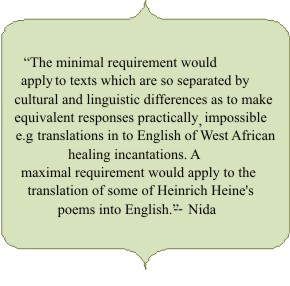Communicative Perspective
The development of communication theory and the concepts associated with it were applied to the field of translation mainly by Nida himself especially in the volume From One Language to Another edited along with de Waard. The communication model that consists of sender, message, receptor, feedback, noise, setting and medium was applied to the translation paradigm also. According to this, translation also is essentially a message that is decoded and then recoded by the translator for the receptor. Sociolinguists who study the use of language in a society have made important contributions to the study of translation based on communication theory. Nida points out that an understanding of the ways in which language is used in interpersonal relationships in any given society is crucial to the act of translation.
Emphasis on the communicative aspects would also mean that the translator is primarily concerned about the translatability of languages. The functions of language – viz. informative, expressive, imperative, cognitive, to name a few – influence translation. In this context Nida points out how, contrary to popular perception, the informative function is perhaps the least important of all functions of language. Attention to functions leads to an attention to “discourse structures” or those of “rhetoric” and “poetics”. This means that an evaluation of a translation “must be in terms of the e xtent to which the corresponding source and receptor texts adequately fulfil their respective functions. (“Theories of Translation”) According to Nida, the minimal requirement for adequacy of a translation would be that the receptor language readers are made aware of the emotional and cognitive responses of the source language readers to the text. Maximal requirement would be that the responses of the receptor language readers are similar to those of the source language ones. Nida observes that the former yardstick can be applied to translations between languages that are far apart in terms of culture and linguistic culture. The ‘maximal requirement' criterion, on the other hand, should be applied to closely related languages like English and French. Theorists like Georges Mounin and Katharina Reiss are examples of those who look to the communication paradigm behind translation theory. xtent to which the corresponding source and receptor texts adequately fulfil their respective functions. (“Theories of Translation”) According to Nida, the minimal requirement for adequacy of a translation would be that the receptor language readers are made aware of the emotional and cognitive responses of the source language readers to the text. Maximal requirement would be that the responses of the receptor language readers are similar to those of the source language ones. Nida observes that the former yardstick can be applied to translations between languages that are far apart in terms of culture and linguistic culture. The ‘maximal requirement' criterion, on the other hand, should be applied to closely related languages like English and French. Theorists like Georges Mounin and Katharina Reiss are examples of those who look to the communication paradigm behind translation theory. |